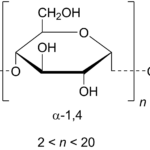What is Maltodextrin

Maltodextrin is a polysaccharide or complex carbohydrate with a dextrose equivalent (DE) rating of between 3 to 20. It is usually in the form of a hygroscopic spray-dried powder and consists of D-glucose units linked primarily by alpha-1-4 bonds in chains of various lengths. The maltodextrin is characterised by its DE rating – the higher the DE value, higher the sweetness, shorter the glucose chain length, higher the solubility, and lower the heat resistance. Generally, maltodextrin is easily digestible and ranges from being moderately sweet to almost flavourless depending on the degree of polymerisation.
Maltodextrin is a white powder that is relatively tasteless and dissolves in water. It is an additive in a wide range of foods, as it can improve their texture, flavor, and shelf life.
It is possible to make maltodextrin from any starchy food, including corn, potato, wheat, tapioca, or rice. Although the powder comes from these natural products, it then undergoes processing.
To make maltodextrin, manufacturers put starch through a process called hydrolysis. Hydrolysis uses water, enzymes, and acids to break the starch into smaller pieces, resulting in a white powder consisting of sugar molecules.
People with celiac disease should be aware that maltodextrin can contain traces of gluten when wheat is the source of the starch. However, according to the Beyond Celiac charity, maltodextrin is gluten-free as long as the ingredients list does not include the word wheat.
Structure

Maltodextrin consists of D-glucose units connected in chains of variable length. The glucose units are primarily linked with α(1→4) glycosidic bonds. Maltodextrin is typically composed of a mixture of chains that vary from three to 17 glucose units long.
Maltodextrins are classified by DE (dextrose equivalent) and have a DE between 3 and 20. The higher the DE value, the shorter the glucose chains, the higher the sweetness, the higher the solubility, and the lower heat resistance. Above DE 20, the European Union’s CN code calls it glucose syrup; at DE 10 or lower the customs CN code nomenclature classifies maltodextrins as dextrins.

The Uses of Maltodextrin
Beverage Industry
Maltodextrin is used in these products including Tang alien drinks, BeShe milk tea, VV soybean milk, Nestle coffee mate, instant lemon tea, Nestle Lactogen milk powder, pearl concentrated solution, and Maxwell mate. The unique properties with reasonable blending help to emphasize the original flavor, reduce nutritive loss, improve the taste and to greatly promote the additional value of products.
Pastry Food
Maltodextrin enables cakes and biscuits to be full in shape, smooth in surface, clear and crystal in color, good in appearance, crisp and delicious, moderately sweet, not sticky with teeth, without residue, less in defective products and longer for the shelf life. Maltodextrin can be converted in the process into thermoplastic gel similar to fat. In the production of some cakes, it can replace fat and decrease the fat content of cakes.
Side Effect

Maltodextrin and Diabetes
Maltodextrin has an even higher glycemic index (GI) than table sugar. This means that maltodextrin can cause a sharp increase, or spike, in people’s blood sugar shortly after they eat foods that contain it. A spike in blood glucose can be particularly dangerous for people with diabetes or insulin resistance.
Allergies or Intolerances
Many food additives can cause allergies or intolerances. Side effects may include allergic reactions, weight gain, gas, flatulence, and bloating. Maltodextrin may also cause a rash or skin irritation, asthma, cramping, or difficulty breathing.
PRODUCT IDENTIFICATION
- CAS NO.
- EINECS NO.
- FORMULA
- MOLAR
- SYNONYMS
- 9050-36-6
- 232-675-4
- C6nH(10n+2)O(5n+1)
- Variable
- Corn syrup solids, modified corn starch, modified rice starch, modified tapioca starch, modified wheat starch
PHYSICAL AND CHEMICAL PROPERTIES
- PHYSICAL STATE
- MELTING POINT
- BOILING POINT
- SOLUBILITY IN WATER
- DENSITY
- PH
- NFPA RATINGS
- STABILITY
- white to off-white powder
- 240°C (dec.)
- 527.1°C at 760 mmHg
- Approx. 1.2 kg/L
- 1.44 g/cm3
- 5 – 7 (10% Solution)
- Health: 1 Flammability: 1 Reactivity: 0
- Slightly soluble to insoluble in anhydrous alcohol
